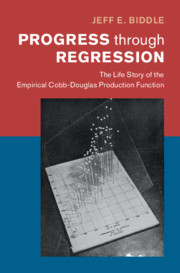Book contents
- Progress through Regression
- Historical Perspectives On Modern Economics
- Progress through Regression
- Copyright page
- Dedication
- Contents
- Figures
- Acknowledgments
- Introduction
- Part I Paul Douglas and His Regression, 1927–1948
- Part II The Diffusion of the Cobb–Douglas Regression
- 4 Three Important Developments in the Life of the Cobb–Douglas Regression, 1952–1961
- 5 The Cobb–Douglas Regression in Agricultural Economics, 1944–1965
- 6 The Cobb–Douglas Regression as a Tool for Measuring and Explaining Economic Growth
- Part III Conclusion
- References
- Index
- Historical Perspectives On Modern Economics
6 - The Cobb–Douglas Regression as a Tool for Measuring and Explaining Economic Growth
from Part II - The Diffusion of the Cobb–Douglas Regression
Published online by Cambridge University Press: 30 October 2020
- Progress through Regression
- Historical Perspectives On Modern Economics
- Progress through Regression
- Copyright page
- Dedication
- Contents
- Figures
- Acknowledgments
- Introduction
- Part I Paul Douglas and His Regression, 1927–1948
- Part II The Diffusion of the Cobb–Douglas Regression
- 4 Three Important Developments in the Life of the Cobb–Douglas Regression, 1952–1961
- 5 The Cobb–Douglas Regression in Agricultural Economics, 1944–1965
- 6 The Cobb–Douglas Regression as a Tool for Measuring and Explaining Economic Growth
- Part III Conclusion
- References
- Index
- Historical Perspectives On Modern Economics
Summary
This chapter describes a process in which a number of long-standing hypotheses about sources of economic growth came to be represented as a series of modifications to Solow’s basic neoclassical production function, which in turn led to attempts to test empirically these hypotheses using production function regressions. Particular attention is given to two empirical research programs that made use of variants of Douglas’s regression procedure: the literature on “embodied technical change” initiated by Robert Solow, and Zvi Griliches’s work measuring the causes of economic growth, both of which emerged in the late 1950s and early 60s. Griliches and Solow proposed empirically tractable ways of testing various hypotheses about causes of economic growth. Their proposals were attractive in part because they made use of an empirical procedure, production function estimation, that involved statistical methods that were coming to be the foundation of graduate training in econometrics, and because they were expressed in terms of the mathematical neoclassical theory that was becoming central to graduate training in economic theory.
Keywords
- Type
- Chapter
- Information
- Progress through RegressionThe Life Story of the Empirical Cobb-Douglas Production Function, pp. 215 - 296Publisher: Cambridge University PressPrint publication year: 2020

